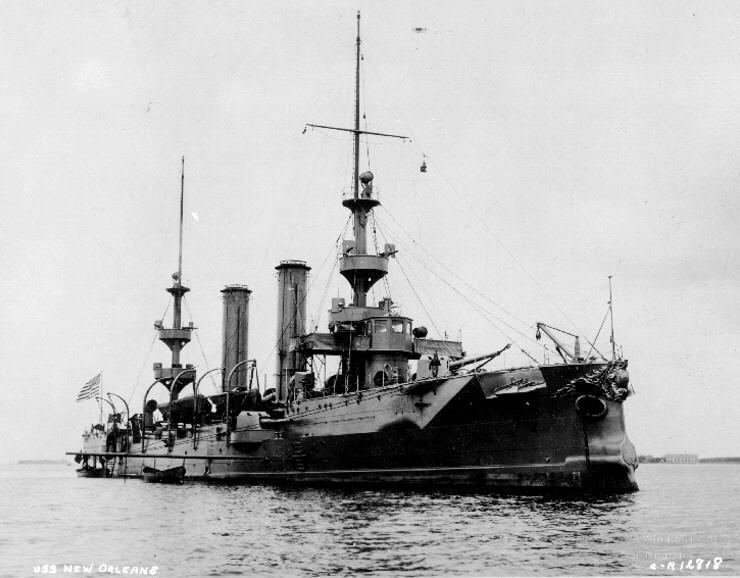Preceded by Columbia class Built 1895–1900 | Succeeded by Denver class | |
 | ||
Builders Armstrong Whitworth, Elswick, England | ||
The New Orleans class of protected cruisers of the United States Navy consisted of two ships which were building for the Brazilian Navy at Elswick, near Newcastle Upon Tyne, England, by Armstrong Whitworth. The Brazilian Navy had ordered four Elswick cruisers, but had already sold the first ship during construction to Chile as Ministro Zenteno. One ship was delivered to Brazil, named Almirante Barroso. The third ship was fitting out as Amazonas, and the fourth was on order as Almirante Abreu.
Contents
On 16 March 1898 the United States Navy purchased the undelivered ships to prevent them being acquired by the Spanish Navy and to augment the US Navy shortly before the Spanish–American War.
Armament
These ships were originally armed with six 6-inch (152 mm)/50 caliber rapid fire (RF) guns and four 4.7-inch (119 mm)/50 caliber RF guns. These were British-made export-model guns built by Elswick Ordnance Company, a subsidiary of Armstrong. One source states the 6-inch guns were Elswick Pattern DD and the 4.7-inch guns were Pattern AA. These guns were unique in the US Navy, and they were designated as "6"/50 caliber Mark 5 Armstrong guns" and "4.7"/50 caliber Mark 3 Armstrong guns". The 6-inch guns were arranged with one each fore and aft, and two each fore and aft in sponsons on the sides to allow ahead or astern fire. The 4.7-inch guns were on the broadside. Three 18-inch (457 mm) torpedo tubes for Whitehead torpedoes were also equipped. Additional weapons included ten 6-pounder (57 mm (2.2 in)) Hotchkiss RF guns, eight 1-pounder (37 mm (1.5 in)) RF guns, and four .30-cal. (7.62 mm) Maxim machine guns.
Armor
Harvey armor was used on these ships. The armored deck was 3 1⁄2 in (89 mm) on the sloped sides and 1 1⁄4 in (32 mm) in the flat middle. The main guns had 4 in (102 mm) shields and the conning tower had 4 in (102 mm) armor. One source also lists 4 in (102 mm) on the boiler room glacis.
Engineering
The engineering plant included four double-ended coal-fired Scotch marine boilers supplying steam to two inverted vertical triple expansion engines (made by Humphrys & Tennant in New Orleans, Hawthorn Leslie in Albany), which produced 7,500 ihp (5,600 kW) for a design speed of 20.5 knots (38.0 km/h; 23.6 mph), which was achieved on trials. The normal coal allowance was 512 tons, but this could be increased to 747 tons.
Refits
To reduce supply difficulties, during refits at the Cavite Navy Yard in the Philippines in 1903, both ships had their 4.7-inch guns replaced with standard 5-inch (127 mm)/50 caliber Mark 5 guns; the 6-inch guns were replaced with additional 5-inch guns in 1907. Their torpedo tubes were also removed in the 1903 refits. At least some of the guns from these ships were emplaced in the Grande Island/Subic Bay area 1907-1910 and operated by the United States Marine Corps until the Coast Artillery Corps' modern defenses centered on Fort Wint were completed. During World War I the 5-inch guns were reduced from ten to eight and a 3-inch (76 mm)/50 caliber anti-aircraft gun was added. At least one 6-inch gun Mark 5 was delivered to the Army during that war for potential service on M1917B field carriages on the Western Front; it is unclear if these weapons were shipped overseas.
Service
New Orleans (ex-Amazonas) served in the Spanish–American War, World War I and the Russian civil war in Siberia.
Albany (ex-Almirante Abreu) was completed too late to see service in the Spanish–American War. She served first in the Philippine–American War and then in World War I and the Russian civil war in Siberia.
Both cruisers were decommissioned in 1922 and were sold for scrapping in 1930.
Ships in class
The two ships of the New Orleans class were:
These ships did not initially have hull numbers. On 17 July 1920 they were designated with the hull numbers PG-34 (gunboat) and PG-36. On 8 August 1921 they were redesignated with the hull numbers CL-22 (light cruiser) and CL-23.
Legacy
Two 4.7-inch guns (one from each ship of the class) are preserved at the Kane County, Illinois Soldier and Sailor Monument at the former courthouse in Geneva, Illinois.
